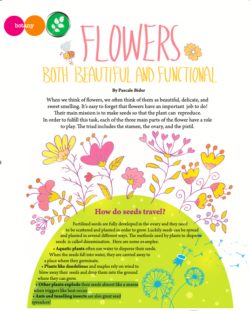Flowers – both beautiful and functional
When we think of flowers, we often think of them as beautiful, delicate, and sweet smelling. It’s easy to forget that flowers have an important job to do! Their main mission is to make seeds so that the plant can reproduce.
In order to fulfill this task, each of the three main parts of the flower have a role to play. The triad includes the stamen, the ovary, and the pistil.


How do seeds travel?
Fertilized seeds are fully developed in the ovary and they need to be scattered and planted in order to grow. Luckily seeds can be spread and planted in several different ways. The methods used by plants to disperse seeds is called dissemination. Here are some examples:
• Aquatic plants often use water to disperse their seeds. When the seeds fall into water, they are carried away to a place where they germinate.
• Plants like dandelions and maples rely on wind to blow away their seeds and drop them into the ground where they can grow.
• Other plants explode their seeds almost like a sneeze when triggers like heat occur.
• Ants and tunelling insects are also great seed spreaders!
The Stamen
The stamen is the peripheral part of the flower that looks like little antennae. Its role is to produce pollen. The anther is the part of the stamen that contains pollen, while the filament is the rod that holds up the anther.
The Pistil
The pistil is the central part of the flower that is responsible for growing seeds. It is comprised of the
sticky stigma that catches the pollen, and the style that carries the pollen from the stigma down to the ovary at the center of the flower.
The Ovary
The ovary contains the ovules. When the pollen reaches the ovules, the flower is fertilized and seeds begin to grow.
Pollen
In order for pollen to travel from the anther to the stigma, the flower often needs help from pollinators. Bright, colourful petals are in fact a strategy used by flowers to attract pollinators.
Pollinators
The most famous pollinators are bees, but bats, flies, moths, and even some birds are pollinators too! Plants lure pollinators in with sweet smells and tasty nectar. As they feast on nectar, they pick up pollen on their legs and bodies. They then carry the pollen over to the stigma of a new flower, which gets fertilized.
Animals can also help disperse seeds!
Sometimes seeds get stuck in a passing animal’s fur. When the animal brushes the seed off, it lands on the ground where it can grow. In other cases, animals, like birds, might eat the seeds. The seeds pass through the animal’s digestive tract before being pooped out. This way, the seed is planted and fertilized all at once!
